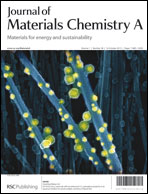Branched polyaniline/molybdenum oxide organic/inorganic heteronanostructures: synthesis and electromagnetic absorption properties†
Abstract
In this work, we developed an efficient and facile method to fabricate branched polyaniline (PANI)/α-MoO3 organic/inorganic heteronanostructures. Scanning electron and transmission electron microscope measurements showed that PANI nanorods with an average diameter and length of about 55 and 110 nm respectively were grown perpendicularly on the surfaces of α-MoO3 nanorods and the density of the PANI nanorods could be readily controlled by simply changing the addition amount of aniline in the reaction system. The minimal reflection loss for the electromagnetic wave absorbent material was up to −33.7 dB at 16.88 GHz for the branched heteronanostructures/paraffin composites with a thickness of 2.0 mm, and all of the minimal reflection losses were less than those of the pure PANI nanorods in the frequency range of 2–18 GHz. More importantly, the content of the branched nanostructures in the paraffin matrix was only 10 wt%. Thus, the method presented here is a very efficient strategy to fabricate lightweight materials for strong electromagnetic wave absorbents.


 Please wait while we load your content...
Please wait while we load your content...